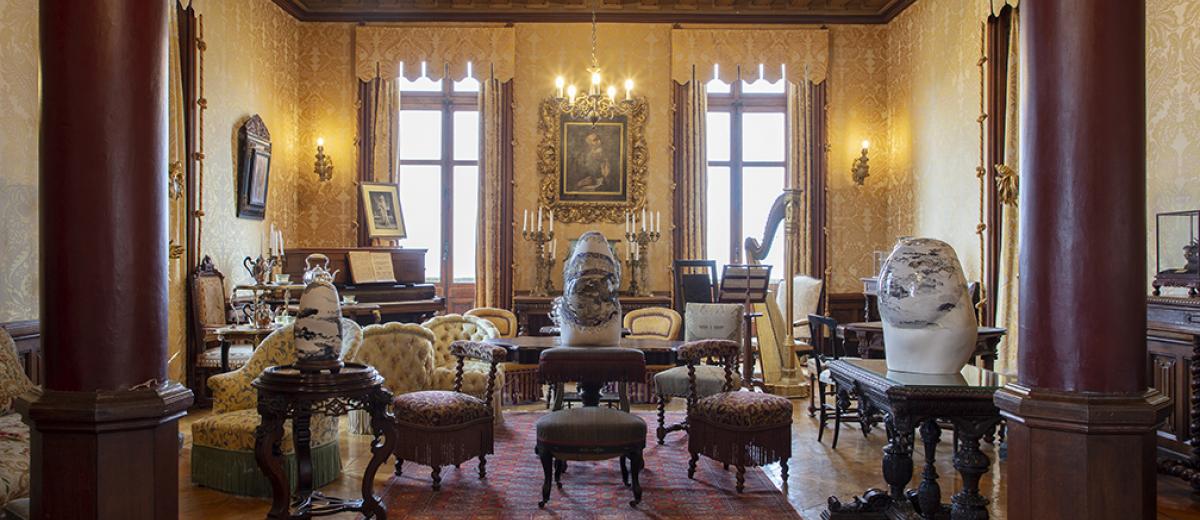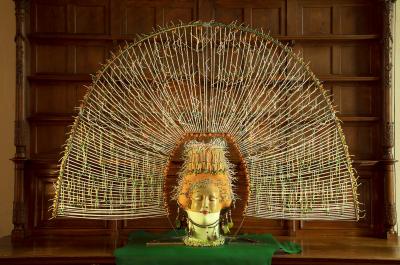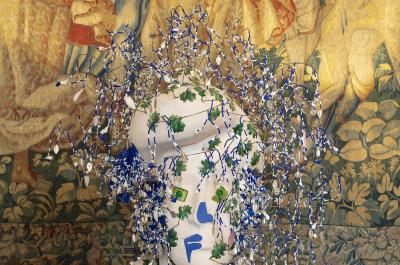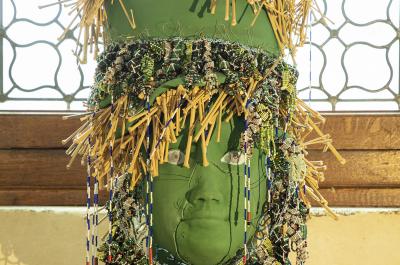A. Françoise Vergier

Françoise Vergier’s art takes the principal forms of object-sculptures and drawings. Her works question a humanity tested by the world. Between heaven and earth, a female body, an autobiography:
“My work vacillates between extreme archaism (the owl that heralds both birth and death) and the contemporary world (its currentness). Between art and life (I put up small altars to all feelings). Between painting and sculpture (I paint sculptures). Between art and nature (from my studio, I observe the beautiful mechanics and magnificent cogs of nature which assert themselves in opposition and complete each other). My sculptures answer the harmony of nature, saying “Thank you”, “So it is”, “Yes”; they seek to reconcile and appease. I also create to know who I am, in short, to travel through the realities of my presence in the world and respond to them.” Françoise Vergier
Vergier maintains a strong relationship with the earth, and most of her works establish a link between the female body and the landscape, between intimacy and the world. During the 1970s, she distinguished herself through her conceptual aesthetic and included many varying references in her works, such as Courbet, Vermeer, Hölderlin or Giorgione. Starting in the 1980s, her sculpture found a new weight and a more incarnate means of expression in its citations of fragments of the female body: the head, the bust, the hand, the navel, the eye. Halfway between object and sculpture, Vergier’s works sometimes verge on kitsch, but are always concentrations of a strong metaphorical and poetic charge.
Nature and landscape also play an important role in Verdier’s imagination and creations. “My childhood landscape is now that of my studio and has become an intermediary image and the base of my dreams. I am engaged in an active contemplation that leads me to undergo the test of my life story to recreate nature through my work, through its physical, metaphysical, and mythological power. The landscape is one of the media, nature is the central study, and artifice is the means to action.”
BIOGRAPHICAL NOTES


Françoise Vergier was born in Grignan (Drôme) in 1952, the seventh child in a family of farmers. In 1979, she went to study plastic arts in Avignon. She lived for some time in Le Havre and then in Paris before returning to build her studio-home in the heart of her native Provençal landscape. She started out by using oil paint on sculpted wood and doing landscape photography before going on to thematic series of drawings in graphite, chalk pastel, charcoal, and ink wash. She also uses small objects, both poetic and surreal, to ornament altars dedicated to autobiographical or current events. Verdier began producing large-scale works during the 1990s, with carved or moulded sculptures of female bodies.
In 1991 she received her first public commission from the Centre National des Arts Plastiques during the restoration of the house and grounds in Nohant (Indre) where Georges Sand spent a good part of her life. In homage to the author, she created Corambé, a monumental, partly gilded bronze sculpture in reference to a goddess invented by Georges Sand as a child, one of the first signs of her literary calling, as she describes at length in her memoir Histoire de ma vie. A few years later, she created Le jardin Sévigné in Grignan for the 1996 tricentennial of the death of Madame de Sévigné. This botanical sculpture, commissioned by the State, reproduces the letters of the name Sévigné in English calligraphy, arranged in the labyrinthine style of an 18th-century garden. Other public commissions gave the artist the opportunity to compose delicate works like her Limoges porcelain tea service for the French foreign ambassadors or her potpourri piece “Triomphe de Flore” produced in five replicas, plus one artist’s replica by the Manufacture de Sèvres.
From 1995 on, her object-sculptures have been displayed in an exhibit dedicated to her work at the Centre Pompidou in Paris, entitled “oui, j’ai dit oui, je veux bien Oui”. Until 2003, she carried out frequent residencies at the CIRVA (Centre International de Recherche sur le Verre et les Arts). In 2004, the Nîmes Carré d’Art put on a retrospective exhibition of her work called Le paysage, le foyer, le giron et le champ.
In 2009, she participated in the hanging of the modern and contemporary art collection at the Musée de Picardie in Amiens, with the exhibition Ce qui demeure est le futur. The same year she also participated in the “elles@centrepompidou” group exhibition of female artists represented in the collections of the Musée National d’Art Moderne – Centre de Création Industrielle.
Today Vergier has become a figurehead in the field of contemporary art, with exhibitions at the Maison Rouge – Fondation Antoine de Galbert in Paris in 2014, at the MUCEM in Marseille in 2018, and in various art galleries since her début in 1981.
In 2021, she was one of 35 artists selected for the exhibition “Ex Africa: Présences africaines dans l’art d’aujourd’hui” at the Quai Branly – Jacques Chirac Museum. In 2022, besides participating in the Domain of Chaumont-sur-Loire’s Art Season, she presented a solo exhibition at the Espace d’Art François-Auguste Ducros in Grignan, an event planned for 2021 but postponed because of the pandemic.
Today Françoise Vergier divides her time between Paris and Grignan.


